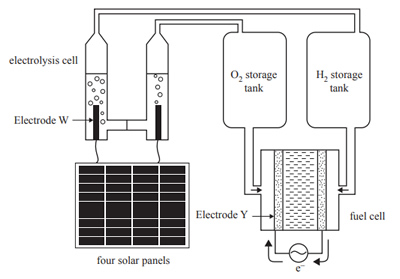1) An energy company investigates the feasibility of supplying energy while reducing greenhouse gas emissions. Solar panels collect energy from the sun during daylight hours and this energy is used to electrolyse water, H2O, to produce oxygen gas, O2, and hydrogen gas, H2. These gases are stored separately and then used in a fuel cell to produce energy when required. The diagram below shows a simplified representation of the set-up used.

i. State the polarity of Electrode W in the electrolysis cell.
ii. The fuel cell operates in an alkaline environment. Write the half-equation for the reaction that takes place at Electrode Y
Solution

Each of the four solar panels produces an average current of 5.20 A and operates over an eight-hour period. The electrical energy generated is used by the electrolysis cell to produce O2 and H2.
iii. Calculate the amount, in moles, of H2 produced by the electrolysis cell.
Solution
iv. Determine the pressure this amount of H2 gas would exert at SLC in a 10.0 L H2 tank.

v. The fuel cell produces 3553 kJ when 20 mol of H2 is consumed. Another possible energy source is a generator using petrodiesel as a fuel. The generator operates with an efficiency of 35%. A particular petrodiesel containing a range of hydrocarbons has been found to have a heat content of 45 kJ g–1. The formula for this petrodiesel can be represented by C12H24 (M = 168 g mol–1).
Calculate the mass of petrodiesel required to produce 3553 kJ.
Solutions to iv and v.
vi Calculate the mass of CO2 (g) released when 3553 kJ of energy is produced from petrodiesel.
vii. How would the mass of CO2 produced from the combustion of this petrodiesel compare with the mass of CO2 produced by the fuel cell?
Solutions to vi and vii.

2) Which one of the following statements is the most accurate?
A. All fuel cells are galvanic cells.
B. All galvanic cells are primary cells.
C. All secondary cells have porous electrodes.
D. All fuel cells are more efficient than all secondary cells.
Solution

5) The overall reaction for an acidic fuel cell is shown below.
2H2 + O2 → 2H2O
Porous electrodes are often used in acidic fuel cells because they
A. are highly reactive.
B. are cheap to produce and readily available.
C. are more efficient than solid electrodes at moving charges and reactants.
D. provide a surface for the hydrogen and oxygen to directly react together.
Solution
